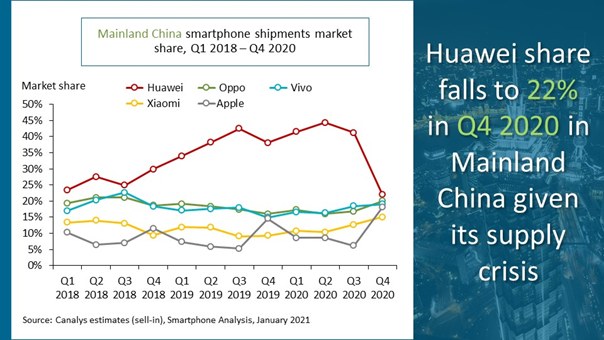The impact of the U.S. government’s sanctions on Huawei continues to hurt the company and dampen overall smartphone shipments in China, where it’s the largest smartphone supplier, according to a new report from Canalys. Huawei’s demise also opens up new opportunities for its main competitors, including Apple.
Apple’s performance in China in Q4 2020 was its best in years thanks to the iPhone 11 and 12, according to Canalys. Full-year shipments returned to 2018 levels, hitting the highest quarterly shipments in China since late 2015 when the iPhone 6s hit the market.
Overall, smartphone shipments in China fell 11% to around 330 million units in 2020, with the market recovery being hampered by Huawei’s inability to ship new units. Although demand in China for Huawei devices remains high, the company is struggling to cope with the sanctions imposed by the U.S. government under the Trump administration that prohibited it from doing business with American companies, and its own Dramatically restricted ability to procure new chips.
In May 2020, Huawei rotating chairman Guo Ping said that although the company can design some semiconductor components such as integrated circuits, it is “unable to do many other things.”
This means that Huawei has not been able to meet the demand for its devices, but it does offer its main competitors new opportunities, wrote Nicole Peng, vice president of mobility at Canalys. “Oppo, Vivo and Xiaomi are battling to attract Huawei’s offline channel partners across the country, including small rural ones, supported by huge investments in store expansion and marketing support. These commitments produced immediate results and market share improved within months. “
Apple benefited from Huawei’s decline as the company’s Mate series is the iPhone’s main competitor in the high-end category and only 4 million Mate units shipped in the fourth quarter. “Apple has not relaxed its marketing for the iPhone 12,” wrote Amber Liu, research analyst at Canalys. “Aggressive online promotions for all e-commerce providers combined with widely available trade-in plans and interest-free rates at major banks have made Apple its outstanding performance.”
In the fourth quarter of 2020, smartphone shipments in mainland China fell 4% year over year to a total of 84 million units. Although Huawei maintained its number one position in shipments, Huawei’s total market share fell from 41% last year to 22% and only 18.8 million smartphones were shipped, including units from budget brand Honor, which were agreed to sell in November.
Canalys’ graphic shows the broadcasts of the five largest smartphone providers in China
Huawei’s main competitors, on the other hand, increased their shipments in late 2020. Oppo took second place with 17.2 million smartphones, an increase of 23% over the previous year. Oppos’ closest competitor, Vivo, increased its quarterly shipments to 15.7 million units. Apple shipped more than 15.3 million units, representing a market share of 18% compared to 15% last year. Xiaomi rounded out the five largest suppliers and delivered 12.2 million units, which is an increase of 52% over the previous year.
Huawei’s decision to sell Honor means the brand could quickly gain market share in 2021 as it already has brand awareness, Peng wrote. 5G is also expected to support the shipping of smartphones in China, especially premium models.


Comments are closed.